Road Trip to Oman Northeast Coast
Join us on our incredible road trip to Oman north-east coast, where we explored from Muscat down to Ras Al Jinz and had a fantastic time exploring beautiful architecture, vibrant souqs, stunning mountains, picturesque lakes, lush green wadis, ancient sites and turtle reserves! Read the complete guide below, including personal experience, recommendations and tips.
Disclaimer: When you make a booking or purchase through links on this site, I may earn commission from partners at no extra cost to you. This helps me to build the site and bring you more great posts!
PLAN YOUR TRIP WITH MY FAVOURITE RESOURCES
– Best accommodation site – Booking.com
– Book day tours at Viator.com
– Buy e-sim at Airalo
Road Trip to Oman
We love a road trip to Oman, and this time, we decided to head down the coast with a stop to visit friends in Muscat. But what is so special about Oman that keeps drawing us back?
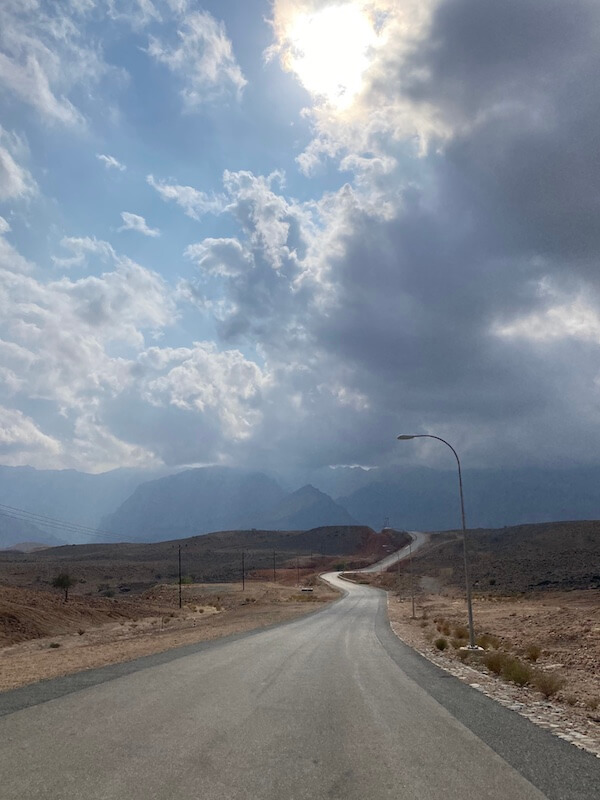
It’s a culmination of factors – the beautiful scenery, a slower pace of life, simplicity, rich traditions, magnificent forts and the friendly and humble locals. Oman is also generally pocket-friendly. For those who want luxury, you can find that too.
Use the table of contents at the top if you want to skip to a specific part.
When setting off on our road trip, I had planned to take the scenic Kalba route from the UAE down to Sohar along the northeast coast of Oman. However, I missed the exit and found myself on the Hatta route. After driving through the Hatta border, the road is incredibly dull as it’s wide and straight, has little traffic and a distinct lack of scenery. I wished I’d downloaded an audiobook or some podcasts to relieve the boredom.

If you prefer a coastal route and a more interesting drive, you can still cut across to Sohar and down the coast. This detour only adds a little time to your journey, and it’s also an option if you’re driving to Oman from Abu Dhabi on Route 7.
As we approached Muscat on Route 1, the dull drive suddenly became more interesting as the highway carved its way through strikingly vibrant orange rock. I couldn’t help thinking what an incredible commute it would be from the suburbs.

After a couple of nights in Muscat, we continued our journey south. Our stops included Wadi Dayqah, Bimmah Sinkhole, Wadi Shab, Qalihat, Sur, and Ras Al Jinz. Along the way, we encountered a variety of landscapes and experiences—from gorgeous lakes and geological wonders to stunning hikes and turtle-watching.
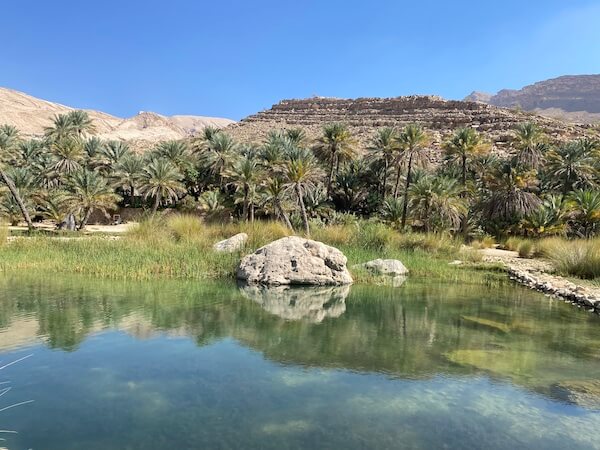
Our adventure didn’t stop there as from Ras Al Jinz, we headed towards Al Hamra near Nizwa, taking in the sights at Wadi Bin Khalid and then spending a night on Jebel Shams. I have already covered Nizwa and the surrounding area, so I have updated that post rather than adding it here. Take me to Best Things to do in Nizwa.
And now, let’s take a more in-depth look that will help you plan a trip to Oman.
Muscat
Muscat is very different from other capitals in the Gulf region. As you enter the capital, notice the skyline, not cluttered with skyscrapers, but dotted with colourful domes and minarets rising into the sky.
Buildings of more than 14 floors are not permitted, and the tallest building is the Sheraton at 53m. The mountains surrounding the city provide a beautiful backdrop rather than being blocked out by tall buildings.
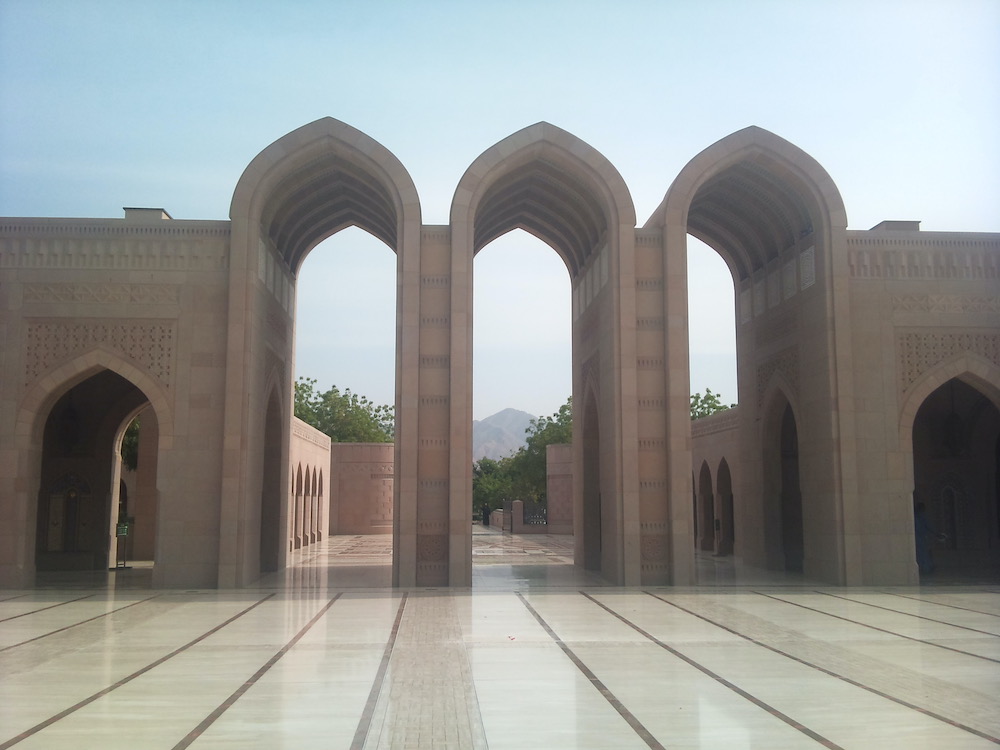
This was our first stop on our road trip and we stayed with friends for a couple of days. We visited a few sights and drove out to the new Muscat Jumeirah Bay for drinks and cake.
Sultan Qaboos Mosque
Completed in 2001, the Sultan Qaboos Grand Mosque is an architectural masterpiece and haven of calm in the city of Muscat. Covering an area of 416,000 square metres, it is one of the largest in the Arabian Gulf and has a capacity for 20,000 worshippers.

The central dome rises to a height of 50 meters and is flanked by five minarets, symbolising the five pillars of Islam. The tallest stands 90 metres high and the others 45.5 metres. The mosque also features an internal courtyard.
Once in the main prayer hall, you’ll notice the walls of white and grey marble decorated with leaf patterns and geometric designs, carved wooden doors, stained glass, and other examples of Islamic art styles from Andalusia to China.
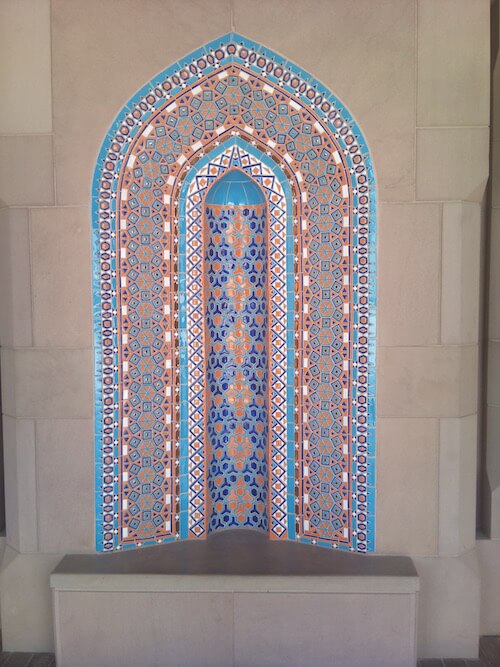
On the floor is a single-piece handwoven Persian carpet covering an area of 4,200 square meters. It took around 27 months to make and is one of the largest in the world. Above, hanging from the intricately decorated dome, is a magnificent Swarowski chandelier with 600,000 pieces of crystal. It was briefly the largest in the world but remains one of the most beautiful.

Visitors are allowed to enter Sultan Qaboos Grand Mosque in Muscat from 8 to 11am every day except Friday. The dress code is modest, covering arms and legs, and women should cover their hair. Photography is allowed, but be mindful of worshippers who may be praying, making supplications or reading the Quran.
You can visit alone or with a guide. If you go alone, you’ll find people working in the mosque who are very helpful, and you can also take an audio tour or buy a guidebook. I recommend going as early as possible before tour groups arrive.
Is Sultan Qaboos Grand Mosque worth visiting?
Absolutely! The architecture and artwork are stunning and the feeling of peace inside is wonderful. Sultan Qaboos Grand Mosque should be top of your list of places to visit in Muscat.
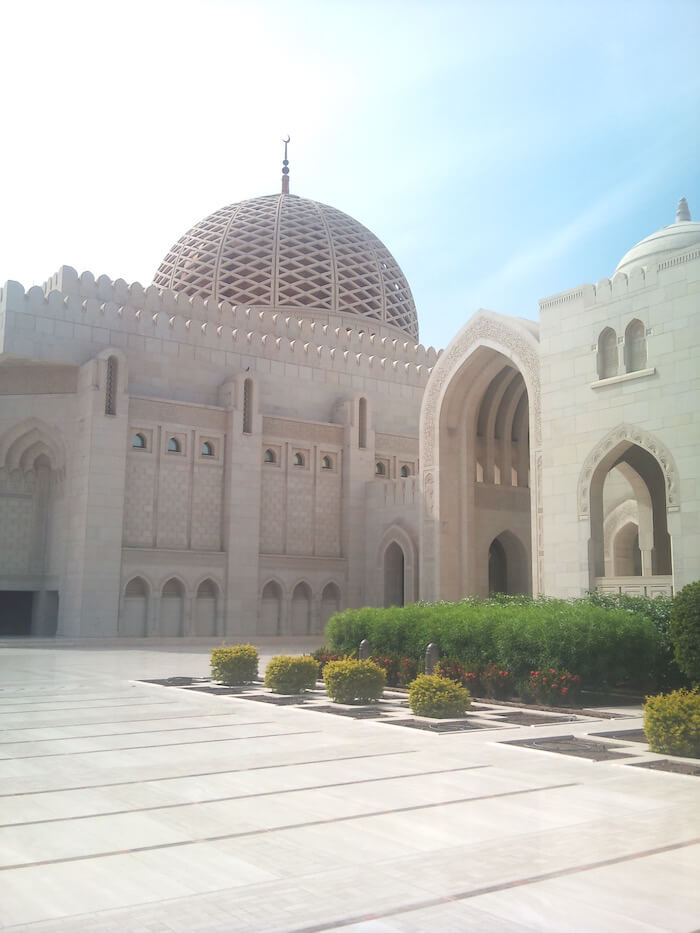
Sultan Qaboos Grand Mosque Muscat Opening Times
Daily except Friday from 8 to 11am
Muscat Royal Opera House
The Muscat Royal Opera House is more than just a concert venue. It’s a work of art with its modern Omani architectural style, Omani marble and interior in a rich blend of gold, cream and red.
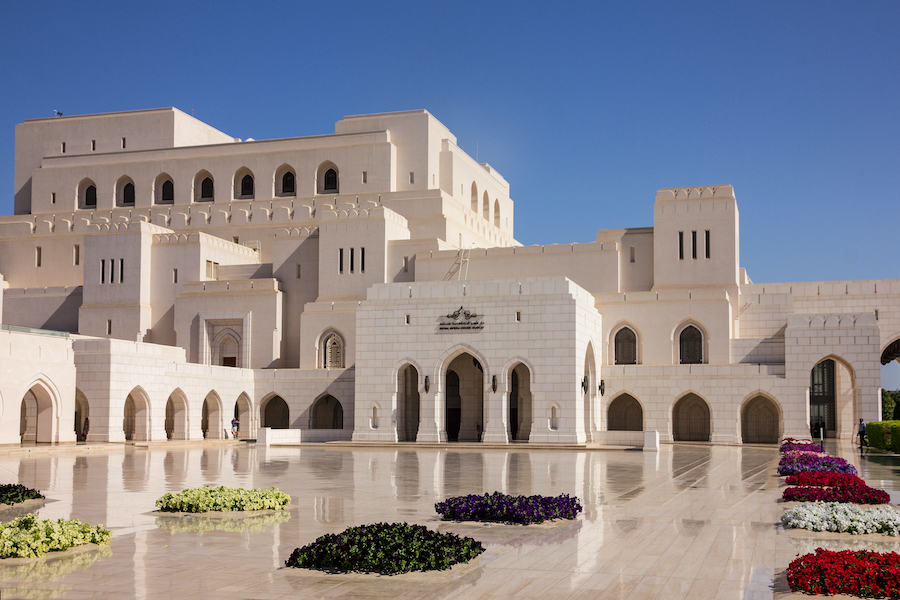
Like many opera houses, it hosts a wide range of music performances other than just opera. Whether you enjoy symphonies or Arabic music, there’s something for everyone if you time your visit right.
Previous performances have included La Traviata, Carmen, the London Symphony Orchestra, Vienna Philharmonic Orchestra and upcoming events include Swan Lake ballet, jazz evening, folk music festival, acrobatic performances, military music and devotional concerts. Look out for events if you’re in Muscat on National Day, Women’s Day, etc.

Even if opera is not your thing, the architecture of the Royal Opera House alone is worth making a detour off the main road. Enjoy the beautifully landscaped gardens, find your way through the maze, relax in a gazebo and watch the world go by.
You can also take a tour if you’d like to see inside. Tickets are available at the box office and the tour takes around half an hour.
Information about Royal Opera House Muscat
Opening times: Tours take place Sat-Thurs from 8:30am to 5:30pm
Ticket Price: Adult 3.15 Omani riyal Child 1.05 OMR or 4.2 OMR and 2.1 OMR depending on the tour
- Can you take photos inside Muscat Opera House? Yes, you can during a tour but it’s not allowed to take photos or videos during performances.
- Can you go inside the Opera House in Muscat? Yes, you can. There are daily tours. See above.
Muttrah
Nestled against the harbour, Muttrah is a bustling hive of activity with traders, workers, shoppers and tourists from the cruise liners docking for a day or two. It’s also home to many government buildings.
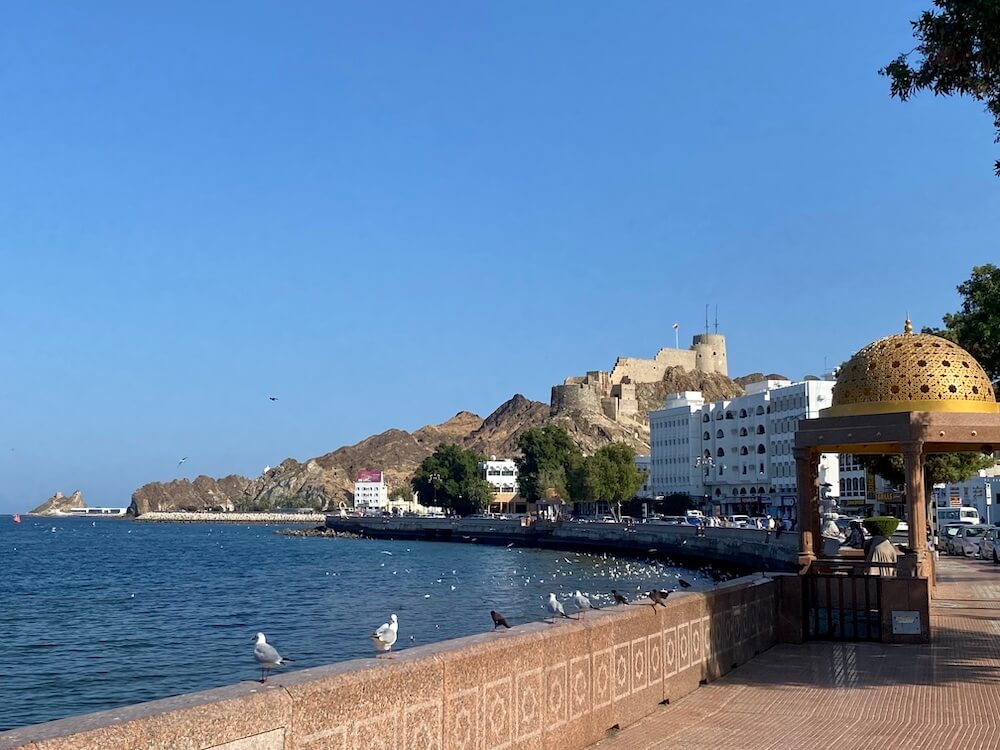
Muttrah Corniche
Stroll along Muttrah Corniche and observe the blend of past and present. High up at the southern end is the 16th-century Muttrah Fort, built by the Portuguese. Along the corniche are traditional Omani houses, the vibrant souq and Al-Rasool Al-A’dham Mosque, with its exquisite blue mosaic dome and minaret.
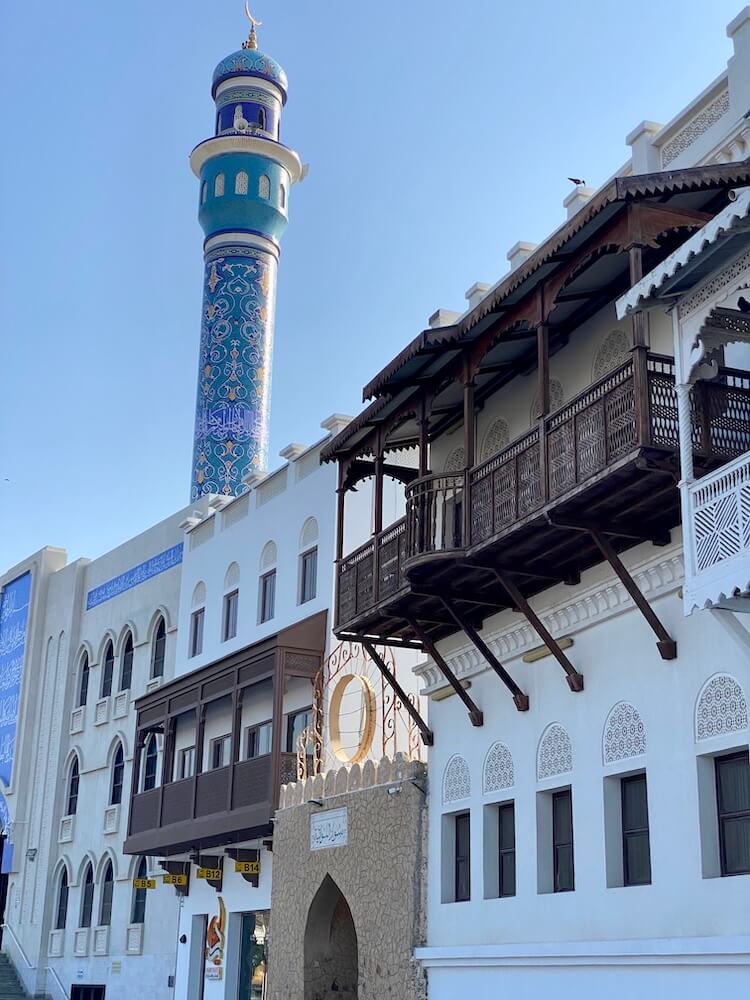
Along the waterside, watch fishermen bringing their daily catch to the market and people gathering to chat. Walking here, I often consider the stark contrast between the wooden dhows near the shore and the enormous cruise liners anchored in the background and the very different lives those aboard the boats live.
Towards the northern end, pass Sultan Qaboos Port and watch the ships docking or stop off at the Fish Market and listen to the animated auctioning of freshly caught fish. The best time to do this is early morning.
Muttrah Souq
First built 200 years ago, Muttrah Souq was a hub for traders from around the world as Muscat sat strategically on the Oman coast between East Asia, Arabia, Persia and Africa. Commodities, such as spices, gold, silk and frankincense, were in demand and were carried from one continent to another via Muttrah Harbour.
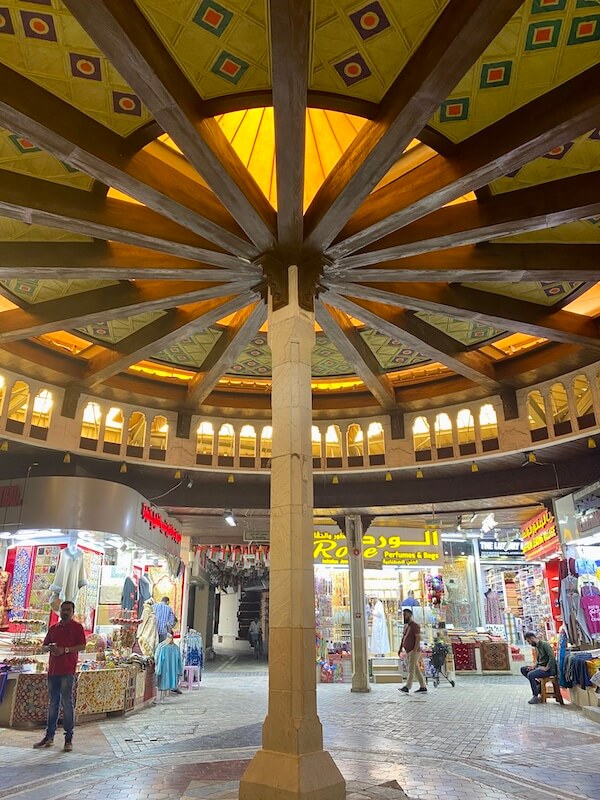
A visit to Muttrah Souq is a must to get a real feel for Omani culture. Again with a blend of past and present, cheap plastic toys are on sale in one shop and old silver daggers and necklaces in the next.
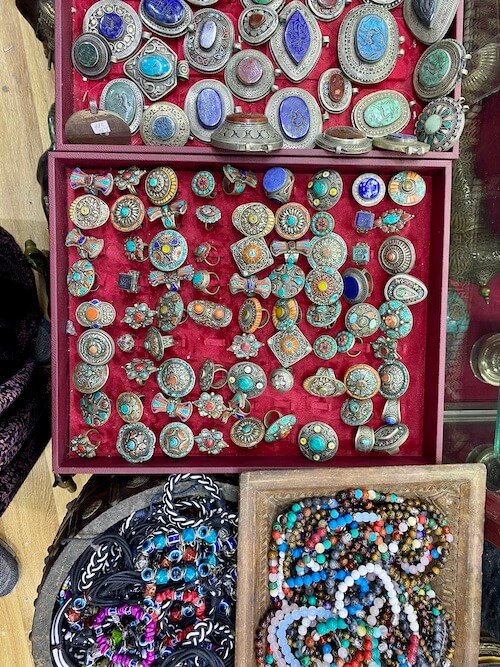
The aromas of spices, perfumes and incense fill the air as you navigate narrow alleyways. Colourful textiles and traditional clothes for sale absorb the heady scents and carry them home. Listen to the animated conversations of shoppers and sellers haggling and enjoying every moment of it.
Although souqs often seem to be just for tourists, you’ll see plenty of locals coming to shop here. During your visit here, you’re witnessing authentic Omani culture rather than just a tourist facade. Take time to observe and don’t be shy to strike up a conversation.

Next, you may be wondering what to buy there. I recommend Arabic oud (perfume), some frankincense (labaan) and a burner, some silver jewellery, Arabic coffee (qahwa), saffron and some frankincense oil if you suffer from aches and pains. Be sure to bargain for whatever you buy. Finally, buy a nice Omani bag to put your shopping in!
Muttrah Fort
Head up to the 16th-century Muttrah Fort for great views of the harbour and the town. There is also a cafe if you want to spend more time there. Muttrah Fort is open daily from 8am to 9pm and the best time to visit for photos is just before sunset. The entrance fee to Muttrah Fort is one Omani riyal.

Bait Al Baranda
Bait Al Baranda is a traditional Omani house containing a museum. It is on the main road going up the hill from the corniche on the left. Despite the status and timings on the Google business profile, it was closed when we went. It seems it’s not currently open to the public but it’s worth checking to see if you’re in the area.
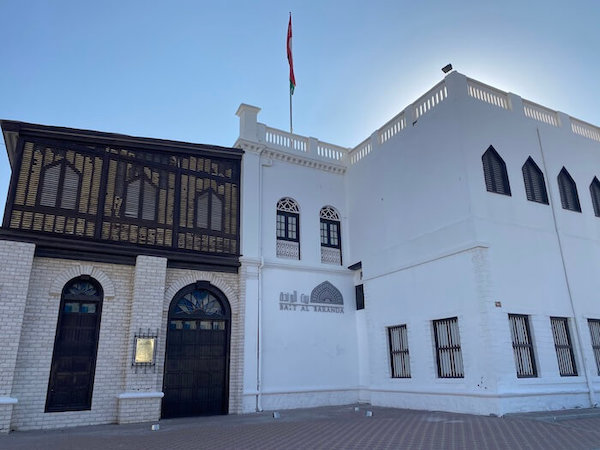
Finally, for somewhere to eat in Al Muttrah, I recommend Bait Al Luban Restaurant, which serves traditional Omani cuisine and has good views. Or, for something cheaper, try some of the other smaller restaurants opposite the port.
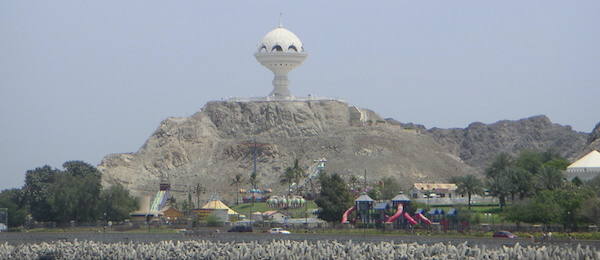
If you continue further along the corniche, you’ll come to Al-Riyam Park. It’s worth driving past to see the giant incense burner up on the hill. The monument was built to celebrate Omani heritage. At night time, it’s lit up.
Al Alam Palace
If you love beautiful architecture, add Al Alam Palace to your Muscat itinerary. The royal structure is simple yet stunning and elegant rather than ostentatious.
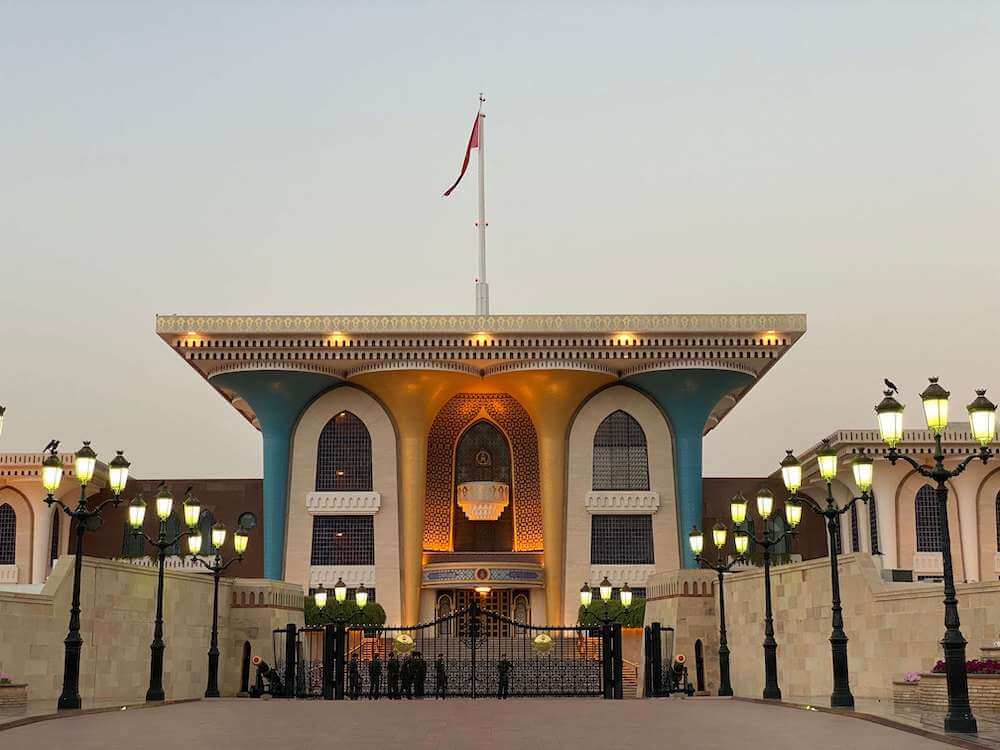
The contemporary design includes Islamic architectural features, such as arches, flared columns and geometric elements, and traditional Omani patterns below the flat roof. The blue and gold exterior adds an air of regality, making the palace look particularly beautiful when lit up in the evening.
Located in old Muscat near the harbour, Al Alam Palace was built two centuries ago and later rebuilt in 1972 as a royal residence and ceremonial palace for Sultan Qaboos, the ruler at the time. Two Portuguese forts, built during the occupation in the 16th century, stand on either side of the Palace, Al Jalali to the right and Al Mirani to the left.
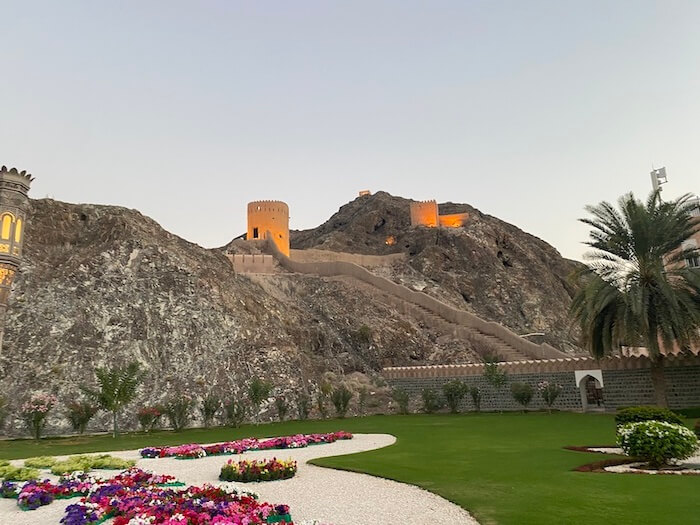
Although it’s not allowed to go inside, it’s still worth visiting to admire the beautiful exterior. Before reaching the palace, you’ll pass through the grounds with a polished forecourt, beautiful gardens and impressive architecture.
You can drive through the grounds and past the Palace and if it’s not too busy, you can park near Al Mirani Fort and walk around.
The National Museum of Oman
The National Museum in Muscat is opposite Al Alam Palace and has several galleries taking you from pre-historic times up to the modern day. Some of the galleries are dedicated to Oman’s listings on the UNESCO World Heritage List.
If you want to learn more about Omani heritage, the Portuguese occupation, frankincense, the fallaj (irrigation system) and maritime history, this is the place to go.
The different sections have interactive exhibits and are accessibility-friendly. It opens daily from 10am to 5pm except Friday 2-6pm and last entrance is 30 minutes before closing time. Tickets are 5 OMR (free for under 6.)
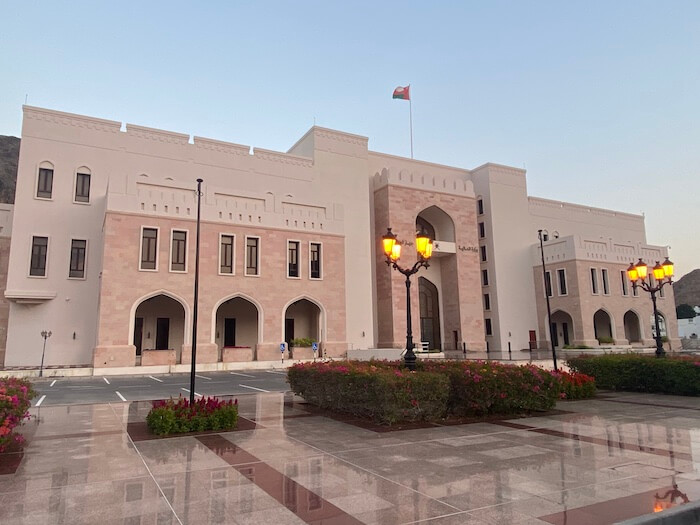
Jumeirah Muscat Bay
Nestled between the dramatic Hajar Mountains and the tranquil waters of the Gulf of Oman, Jumeirah Muscat Bay offers a little luxury away from the city. There is both a resort and a residential area. Consider booking a night here if you’d like to treat yourself to an elegant and peaceful sanctuary. If it takes your fancy, you can even buy a house!
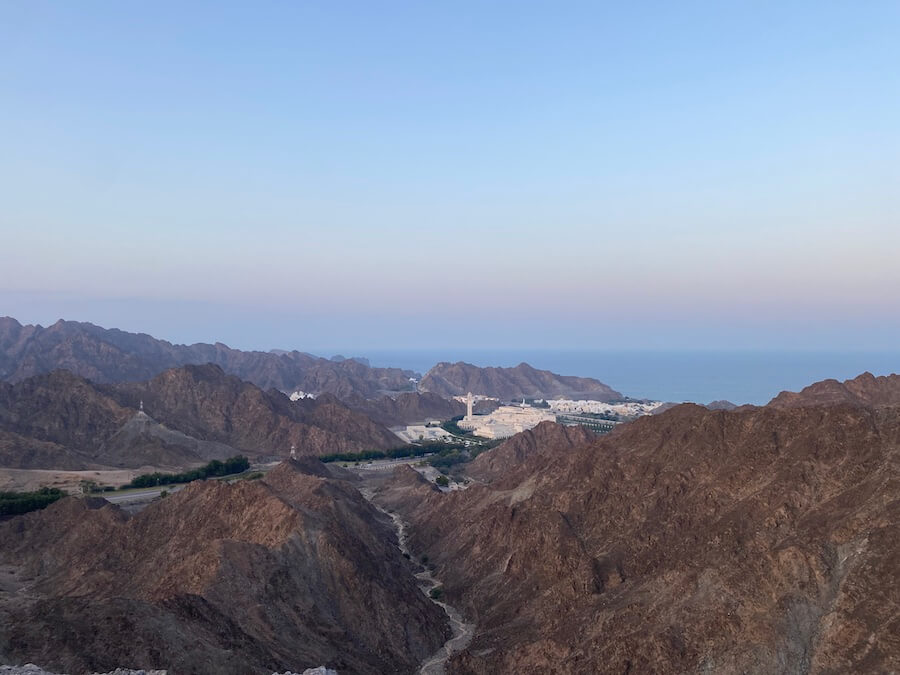
Unfortunately, relaxing at the spa wasn’t on our agenda that day. Instead, we enjoyed a juice and cake with a stunning view at Muscat Bay Cafe.
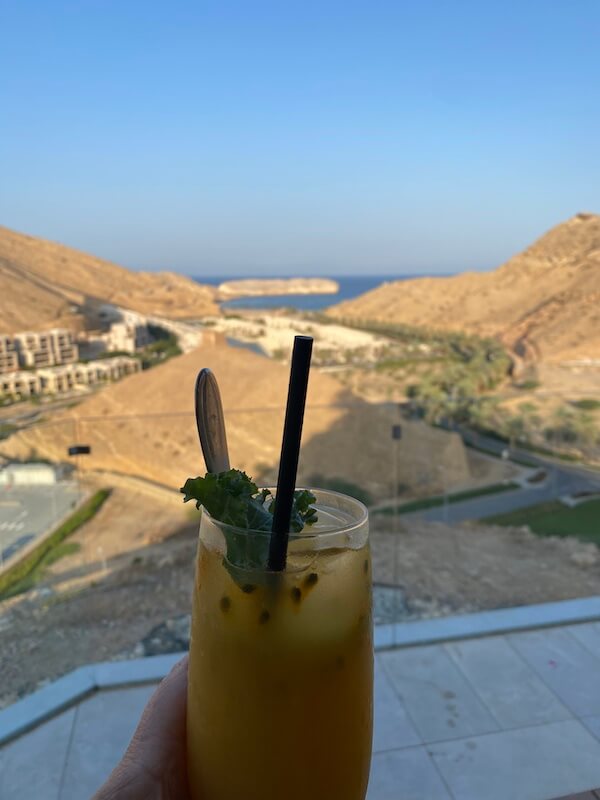
More Places to visit in Muscat
- Qurum Beach
- Muscat Gate Museum
- Natural History Museum
- Bait al Zubair Museum
- Daymaniyat Islands
Where to stay in Muscat
We’ve visited Muscat several times over the years and stayed at various places, including the Crowne Plaza, more than once. If you’re travelling as a family, there are many apartment hotels to rent across Muscat, and that worked well for us when we travelled with young children. Here are some hand-picked options for you with great ratings.
- $$$ Luxury – Book Al Bustan Palace Ritz-Carlton (Exceptional)
- $$ A personal favourite – Book Crowne Plaza Muscat (Excellent)
- $ City centre apartment with outdoor pool and restaurants- Book Citadines Al Ghubra (Exceptional)
Quick Muscat itinerary suggestions
What to see in Muscat in one day
- Visit Sultan Qaboos Mosque.
- Drive past the Opera House and have a quick stop.
- Muttrah – walk on the corniche, go shopping at the souq, eat dinner at Bait Al Luban
2 days in Muscat
- Day 1 – Visit Sultan Qaboos Mosque and the Opera House. Have lunch at the Opera House.
- Day 2 – Visit the National Museum of Oman and Alam Palace and Muttrah
3 days in Muscat
- Day 1 – Visit Sultan Qaboos Mosque and the Opera House. Have lunch at the Opera House.
- Day 2 – take a day trip out of town to Wadi Dayqah to take a boat trip or go kayaking. Or, if you prefer to be on land, you can also rent a mountain bike to set off on one of the two mountain bike trails, one easy and one more challenging. Alternatively, head to Wadi Shab to hike and enjoy a swim in the pools and on to Bimmah Sinkhole. Book a tour.
- Day 3 – Visit the National Museum of Oman and Alam Palace, take a dhow trip from Muttrah, then spend the evening wandering around Muttrah and getting in some shopping at the souq.
5 days in Muscat
- Take a city tour on Day 1 – visit Sultan Qaboos Mosque in the morning and the Royal Opera House. Have lunch at the Opera House.
- On day 2, Visit the National Museum of Oman and Alam Palace, take a dhow trip from Muttrah, then spend the evening wandering around Muttrah and getting in some shopping at the souq.
- Day 3, take a day trip to Nizwa and Jebel Akhdar.
- Day 4 – go snorkelling at Daymaniyat Islands
- Day 5 Have a relaxing last day – treat yourself to coffee at the Bustan Palace Ritz Carlton for a bit of luxury, have lunch at Muscat Bay or take a day trip to Wadi Dayqah.
Wadi Dayqah Dam
Our first stop after leaving Muscat was Wadi Dayqah Dam. After exiting the highway, we took a drive of around 20 kilometres through a scenic route. Once at the dam, we hired a doughnut boat so we could sail all around the lake.

The scenery was gorgeous and we had a lovely hour going across to the other side. We opted for an hour but if you rent it for more, you can go through the channel to the other part of the lake and beyond. It was rather windy that day but the lovely employee on duty came and pulled us back!
If you prefer something more energetic, you can hire a kayak, paddle-board, paddle boat or raft. or if you just want to sit back and enjoy the ride, hire a bigger boat for you and your family or friends.

If you’d like to stay overnight, paid camping is available with tent and barbecue and access to toilet and shower facilities.
All activities are provided by Husaak Adventures who operate daily except Monday from mid September to the end of April. Operating hours are from 1 to 9 pm. For more information, visit the Husaak Adventures website.
After our boat trip, we ate at the cafeteria and had a wander round the large garden area and across the open part of the dam. Sometimes there is a ‘waterfall’ as water flows into the wadi below.
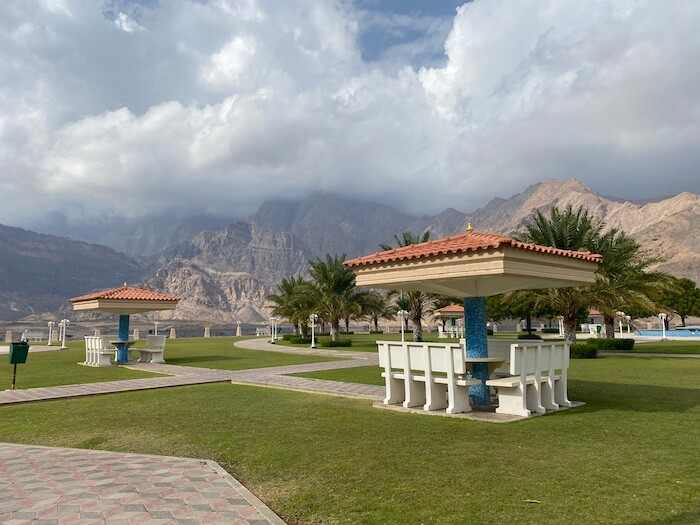
At the top of the hill is a tourist information centre but it doesn’t seem to be open yet.
Even if you’re not planning to go further down the Oman north coast, Wadi Dayqah Dam is worth a day trip from Muscat. The drive from Muscat to Wadi Dayqah Dam took us around an hour and a half. To get to Wadi Dayqah from Muscat, take Route 1, then Route 17 and look out for the exit.
✅ Buy Rough Guide to Oman 2024📗
Bimmah Sinkhole
Back on the road, we continued our journey down the north Oman coast with a stop off to admire one of Oman’s natural wonders – Bimmah Sinkhole.
Bimmah Sinkhole History
Sinkholes are a phenomenon around the world and occur when the land on the surface can no longer be supported from below. The land in this area is mainly limestone, one of the main types of rock susceptible to sinkholes.
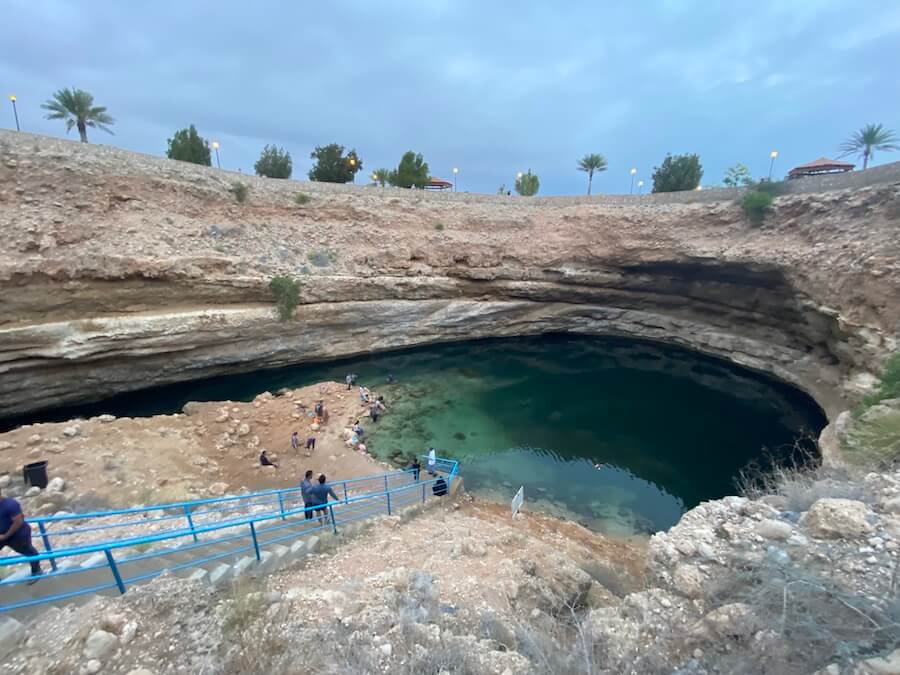
When it is dissolved over time by rainwater and/or groundwater, caverns appear and get gradually bigger until there is no longer enough land to support the ground above. An underwater stream would likely have contributed to the process.
Contrary to this, locals believed it was a well caused by a meteorite hitting, so they called it Falling Star, or Hawaiyat Najm.
Where is Bimmah Sinkhole?
Bimmah Sinkhole in Oman is near the coast and sits inside Hawiyat Najm Park, which was built around it. It takes around an hour and a half to the Bimmah Sinkhole from Muscat and about 25 minutes from Bimmah Sinkhole to Wadi Shab, which was on our itinerary for the next day.
The exit from Route 17 is well-signposted and takes you to the coastal road before turning back inland towards the park.
What can you do at Bimmah Sinkhole
Follow the steps deep down into the sinkhole, which is around 60m wide. Enjoy sitting on the rocks by the turquoise water, take a swim or dip your feet in and wait for the fish to come along and nibble your feet!
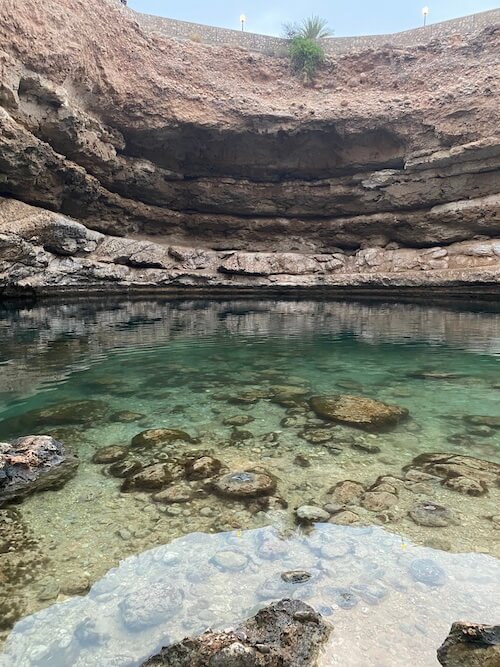
If you’re wondering can you swim in Bimmah Sinkhole, yes, you can, but watch out for deeper areas if you’re not an experienced swimmer. There are shallow areas, so just watch other people before going in yourself.
The water is not stagnant, so it’s clean but it’s a mix of groundwater and seawater. Because of this, it may taste bitter. Note that children may need a floatation device.
You can get lovely photos from above and below if it’s not too busy. Early morning is likely to be the quietest time, especially on weekdays.
You can also relax in Hawiyat Najm Park, which has gardens, benches, a playground and toilets, making it an ideal spot for a picnic to break up your journey down the Oman coast.
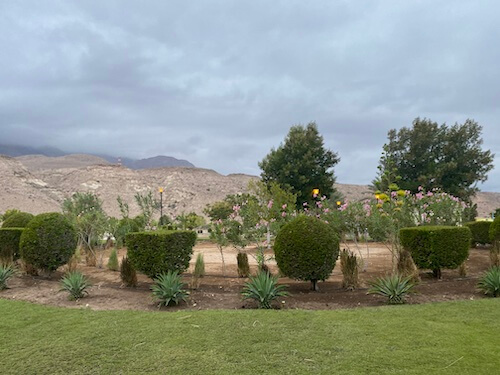
Is Bimmah Sinkhole worth visiting?
At 60m wide, it’s a pretty impressive sinkhole and the colour of the water is gorgeous. If you’re in the area, it’s definitely worth stopping off at. If you’re planning it as a day trip from Muscat, I recommend adding other activities into your itinerary, such as a visit to Wadi Shaab.
What are Bimmah Sinkhole opening times? – Hawiyat Najm Park is open daily from 8am to 8pm
Camping near Bimmah Sinkhole and Fins Beach
For a longer stop here, the coastline is just half a kilometre away from the park and is a perfect spot for camping overlooking the Gulf of Oman. Slightly south is Fins Beach and towards the end there is a paid campsite with campervans and surrounding area to rent.
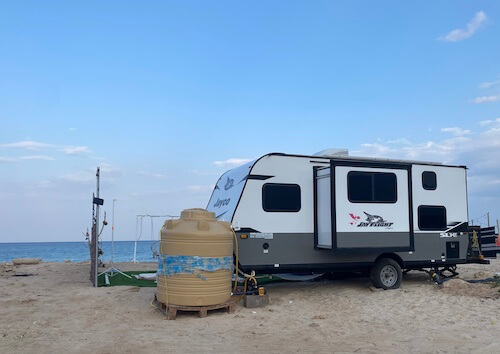
South of that still was a graveyard near the shore with graves decorated with pebbles and shells. I couldn’t help thinking what a beautiful resting place it was. (And passed on instructions to the teen by my side!)
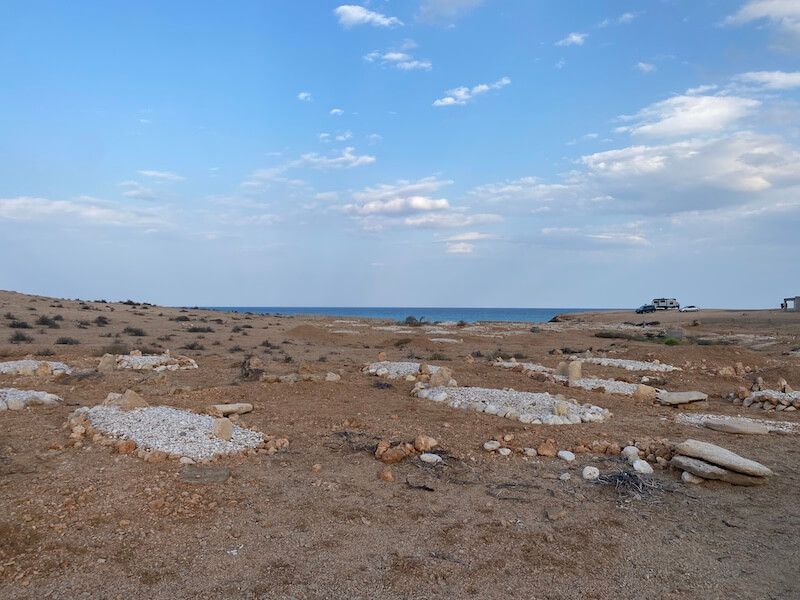
Wadi Shab
Wadi Al Shab is a popular destination in Oman, especially among hikers and nature lovers. The hidden canyon surprises visitors with turquoise pools, rocky paths, lush palm groves and more.
To get there, you first need to take a short boat trip. Finding Wadi Shab Oasis is easy once you take the Tiwi exit off the highway and follow the coastal road until you cross the bridge over the wadi.
Once you’ve found a space, join the queue for the boat, which costs one riyal. Hold on to your ticket as you’ll need it to get back. The crossing only takes a minute so be quick with any photos.
You’ll meet lots of guides on both sides offering to take you up the wadi. You can go by yourself as the path is clear but hiring a local guide can enrich your experience as he’ll give you lots of information, point out things you may not have seen and you’ll also be supporting the local economy.
If you have young children, you might need to hold their hands at some points. If you’re used to European health and safety standards, remember you won’t find them here. Although we saw families with young children, I’d say it’s more suited to those eight and above.
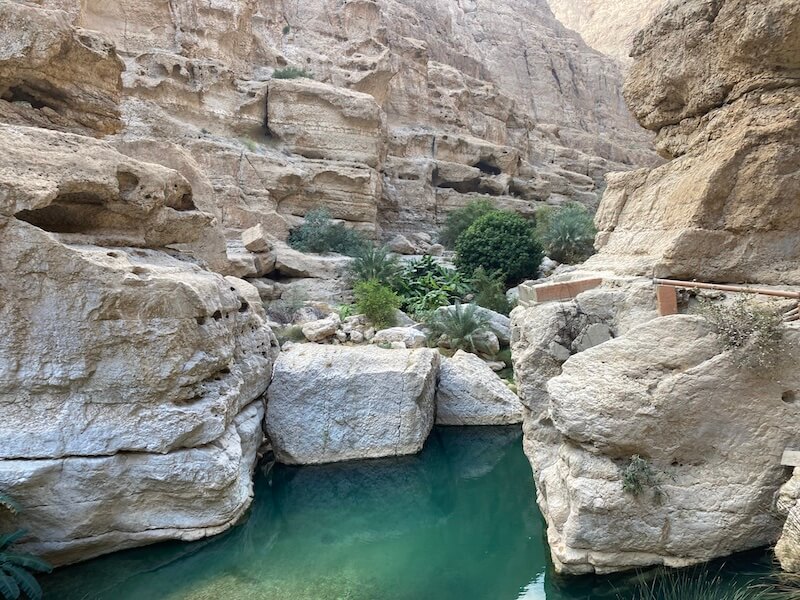
We spent quite some time sitting high up on the rock edge above the pool, just watching everyone having fun, kids splashing, some diving, and someone doing yoga and meditating. There was a cave where we sat that you could climb up into. I couldn’t help thinking how many stories it held over the centuries.
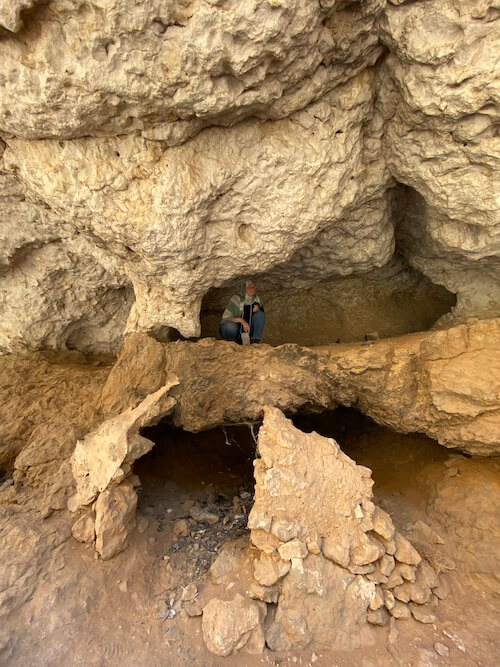
I recommend doing the hike to get the best out of Wadi Shaab. If you want to continue to the hidden Wadi Shab cave and waterfall after the big pool, take a waterproof bag for your valuables. You can leave clothes and shoes on the rocks.
Make sure you have appropriate footwear as you’ll be climbing over rocks and walking on slippery wet surfaces. A decent pair of trainers or similar with a grip is fine most the way. There are no shops or vendors on the way, so pack plenty of water and some snacks in your backpack. If you forgot, there’s a small cafe before the boat crossing to stock up before you go.
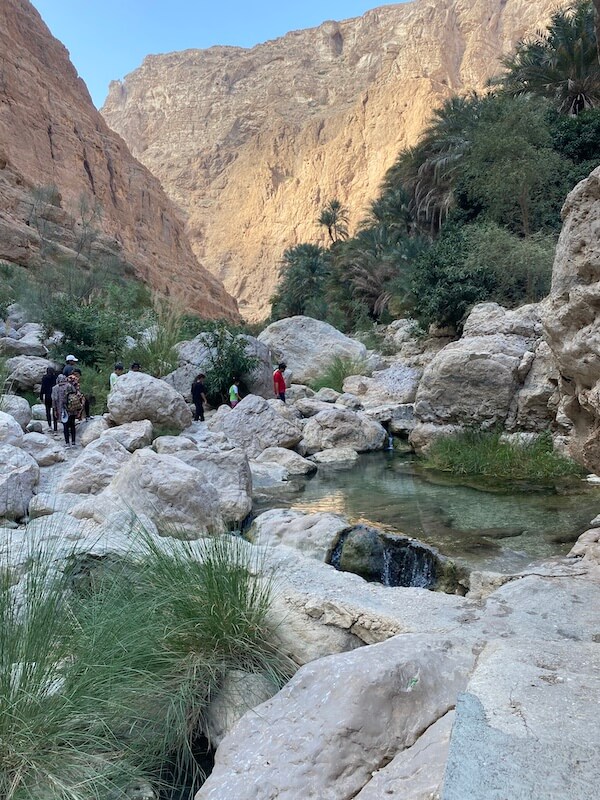
We really enjoyed our time here, and the number of visitors didn’t take too much away from it, so I still recommend it. The scenery was fabulous and I’d go back for sure. The earlier you get there, the better to avoid crowds and the heat.
Key tips for Wadi Ash Shaab
- Go early if possible to avoid crowds and the heat
- Wear shoes with a grip and preferably ankle support, and a hat or other head covering
- Take plenty of water and some snacks
- Take a waterproof bag if you want to go to the cave and waterfall
- Don’t forget your camera for some fabulous shots!
- Consider hiring a guide at the wadi for a richer experience.
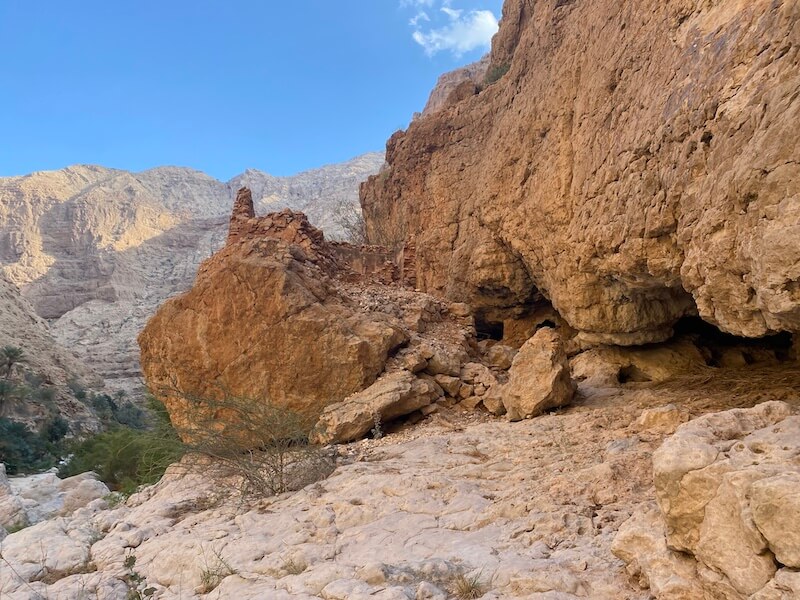
Where to stay at Wadi Shab/Tiwi?
- The most popular place to stay is Wadi Shab Guest House (9.2 on Agoda and Booking) If you stay here, you can enjoy the beach and pool in the afternoon and start your hike early next morning. Book your room at Wadi Shab Guest House
- Chalet in Tiwi – relax with a private pool, hot tub and beach view (9.2) – Book this ultra relaxing stay now
- Wadi Shab Beach House (8.8)- Book your room with ocean view or see more
Bookmark this post now so you can find it again later!
FAQS Wadi Al Shab
- What are the boat timings at Wadi Shab? 7am to 4:30pm
- What is the distance from Muscat to Wadi Shab? It’s around 150km or just under 100 miles from Wadi Shab to Muscat and takes about an hour and a half.
- How to get to Wadi Shab from Muscat? Take Route 1 heading south, then exit onto Route 17 and keep going until the exit for Tiwi. Go through the underpass and go right. Keep going until you reach the wadi.
- How long is the Wadi Shab hike? Around an hour each way
- Is Wadi Shab parking free? Yes, it is. There’s limited space, so you’ll probably just have to find somewhere to park along the road.
Qalhat
Qalhat Beach and new village
Qalhat is a little village and a lovely quiet stop between Muscat and Sur. I booked a night here as it was handy for Wadi Ash Shab but we discovered so much more there too.
We stayed at Alshumukh Guest House, which was comfortable and had all we needed, and we enjoyed an evening sitting on the terrace with sea views and a takeaway from the nearby cafe.
Early next morning, I set off alone for a walk along Qalhat Beach and to watch the sunrise. I then followed the wadi inland and walked back along the road.
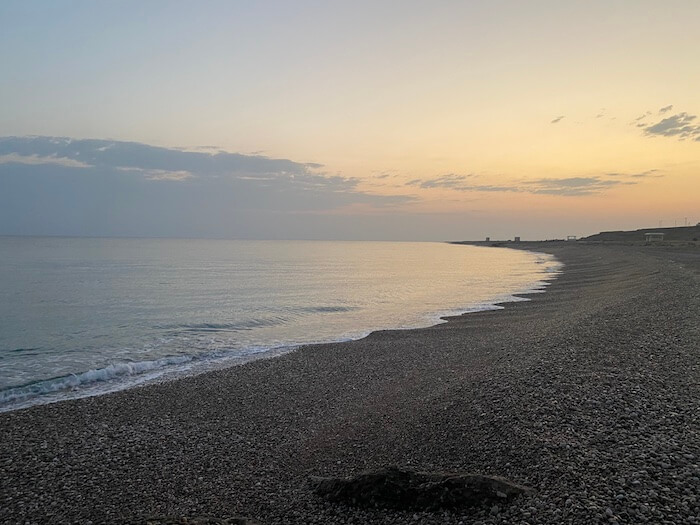
Graves at Qalhat
Apart from a lone flamingo who was also enjoying the early morning solo, I passed several sites of old houses, stores and graves. The first ones were on the left, heading back to the hotel, and the others further up were on the right.
I recommend a decent pair of shoes to do this walk as Qalhat beach is pebbles and the first ruins are set amongst small rocks. (And I may have managed to fall!)
Ancient City of Qalhat
Near the newer village is the Ancient City of Qalhat, a UNESCO Heritage site dating back around 1000 years. Its last inhabitants left at some point in the 1600s.
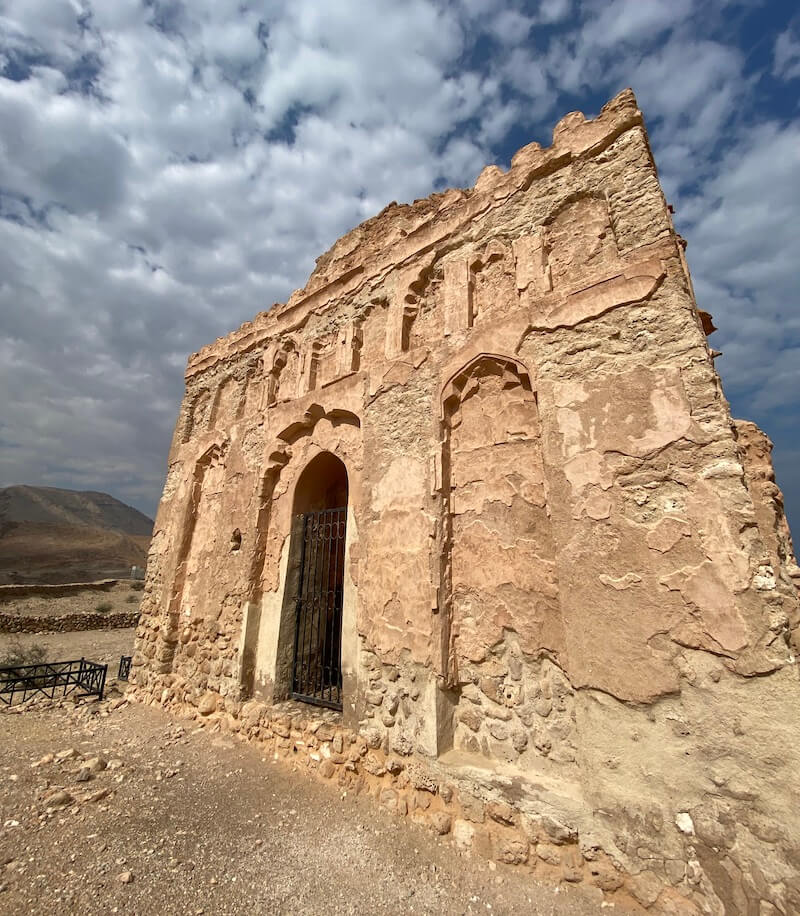
Qalhat was a major city for several centuries, however, when Muscat became the capital, much of the trade moved there. It was later destroyed by the Portuguese when they invaded and sadly, only the mausoleum was left standing. Marco Polo and ibn Battuta were among the many famous travellers who visited it and wrote about it in their records.
The large building is known as Mausoleum Bibi Maryam. The story goes that it was built for the wife of Mahmoud Al Qalhati, Maryam, however, some believe she was the one to order that it be built.
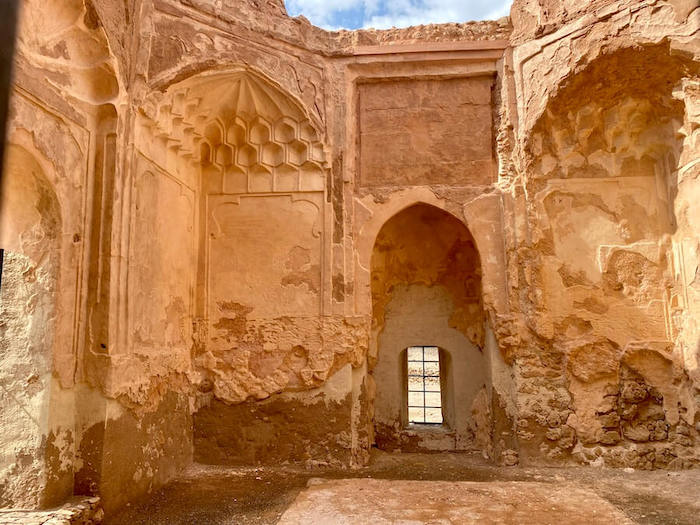
Unfortunately, the Ancient City of Qalhat is currently closed to visitors, and restoration work is starting to take place. So hopefully, it will be open again soon.
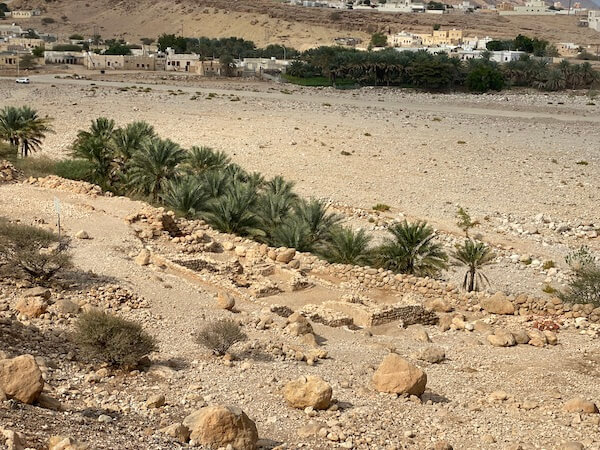
How to get to Qalhat? – Follow Route 17 towards Sur and look out for the sign for Qalhat about 15 minutes after Tiwi/Wadi Shaab. Go under the highway. It’s about two hours from Muscat to Qalhat and half an hour from Qalhat to Sur.
Off-road mountain drive near Qalhat
Under the bridge that goes over the wadi is a road to the mountain. It’s paved some of the way and then turns to an unpaved road. It’s fairly firm, so you could go a fair way without a 4WD but be careful of the uneven surface right at the beginning of the ascent.

The road is a winding trail up the mountain (or hill) and steep at some points. Along the way, you’ll pass some old buildings and fabulous viewpoints. Once at the top, you’ll drive along the mountain and, at different points, have views from either side.
It’s one track most of the way, so you might have to reverse to let someone pass but we only passed a couple of cars all the way.

You can see down to the oasis and village in the valley below. The road forks to go down and the other route continues along the hilltop. Unfortunately, I was getting low on petrol, so I decided to turn back but I’d love to go back one day. It looked like you could drive pretty far.
Go back to the top/table of contents
Sur
Sur is known for its maritime heritage and the best place to learn more is the Maritime Museum. See exhibits of different types of ships and learn more about the history of Sur as a port. Visit the dhow-building yards nearby and see artisans crafting wooden vessels to take to the seas.

Things to do in Sur, Oman, include visiting Sunaysilah Fort, Bilad Sur Castle and Ajyah Lighthouse. Walk along the corniche and watch children at play and fishermen at work, have a picnic on the beach or wander through the old part of town. You can get a good view over the town and bay at Sunaysilah Fort. The entrance fee is 500 baisa.
The drive from Muscat to Sur takes about two and a half hours. For stops on the way to Sur, see the locations mentioned above.
Ras al Jinz
Ras Al Jinz, on the eastern tip of the Oman coast, is part of the Ras Al Hadd sanctuary. In 1966, the Omani government designated it a nature reserve to protect the endangered green turtles and other species. Ras Al Hadd Reserve covers around 120 square miles and is on the tentative list of Unesco World Heritage sites.
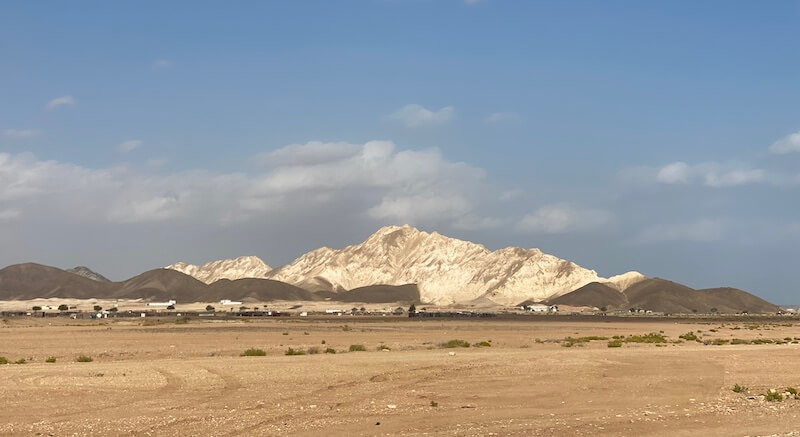
If you visit at the right time, you can witness these endangered creatures nest and hatch in their natural habitat. The nesting season is mainly from May to September. Amazingly, the turtles have swum to Ras Al Jinz Beach from diverse areas of the Indian Ocean, including the Arabian Gulf, Arabian Sea, Gulf of Oman and the Red Sea.
Ras Al Jinz Visitor Centre
To watch turtles lay eggs at Ras Al Jinz, you need to join a guided tour from Ras Al Jinz Visitor Center at night time. Guides lead groups of around twelve to the beach by torchlight.
Once there, you wait for your group’s turn to go to specific spots. Then, you’re likely to see female turtles laying eggs or young hatchlings making their first journey to the sea, depending on the season.
The tour costs 7.5 Omani Riyal (around $20) and lasts 30-40 minutes. Keep in mind that you’ll walk in the pitch dark much of the way. You can use your phone light higher up the beach but not near the turtles.
There are some display boards with information in the centre and a small gift shop. You don’t need to pay to access these. There is adequate parking outside, but you can walk there if you’re staying nearby.
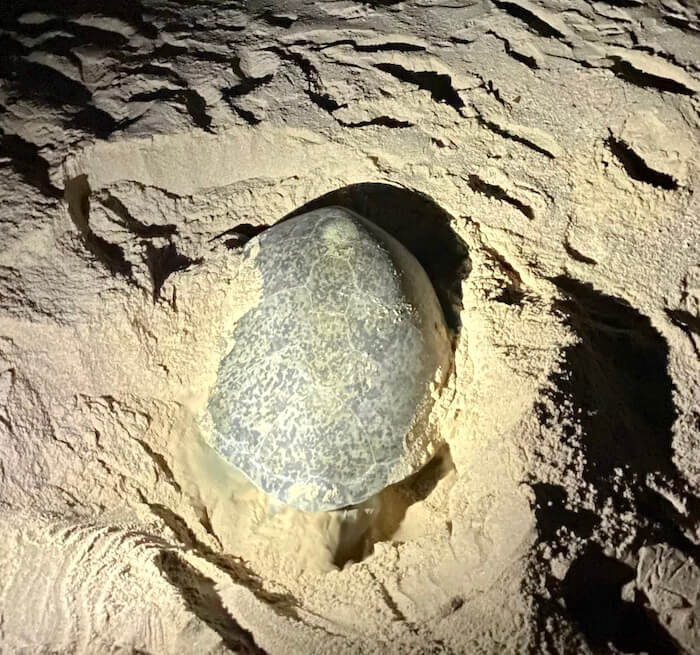
As we went in winter, we saw a few females laying their eggs and burying them. I’ll be honest and say that it was a bit of an anti-climax at this time of year. Yes, we saw turtles laying but it was very brief.
As mentioned above, the ideal Ras Al Jinz turtle season is May to September and it seems August is the best month to experience the hatching. I’d like to make it back for that some day.
Beyond the turtles, the surrounding area was quite scenic and I would have liked to spend another night there.
Where to stay at Ras Al Jinz
You can either stay in Sur and drive down or stay locally. We booked Ras Al Jinz Turtles Guest House, which was pleasant, comfortable enough, clean and the staff were very helpful.
They also had a great buffet dinner and breakfast. Only breakfast was included in the price but the dinner was very reasonable. Turtles Guest House is very reasonably priced and is rated 8.0 on Booking.
Alternatively, you can book Ras Al Jinz Turtle Reserve’s own hotel which offers both rooms and eco-tents and has a private beach.
Book a room at Al Jinz Turtle Resort now
FAQs
- What is the Ras Al Jinz Turtle Reserve Entrance Fee? – It’s free but the tour to see the turtles is 7.5 OMR.
- What is the distance from Muscat to Ras Al Jinz? It’s 250km and the journey takes around three hours.
Wadi Bani Khalid
Wadi Bani Khaled, in Oman’s Ash Sharqiyah region, is an oasis nestled between much more arid surroundings. The wadi has water year-round, creating a lush, green landscape around a large pool, making it look more like Sri Lanka than the Arabian Gulf!
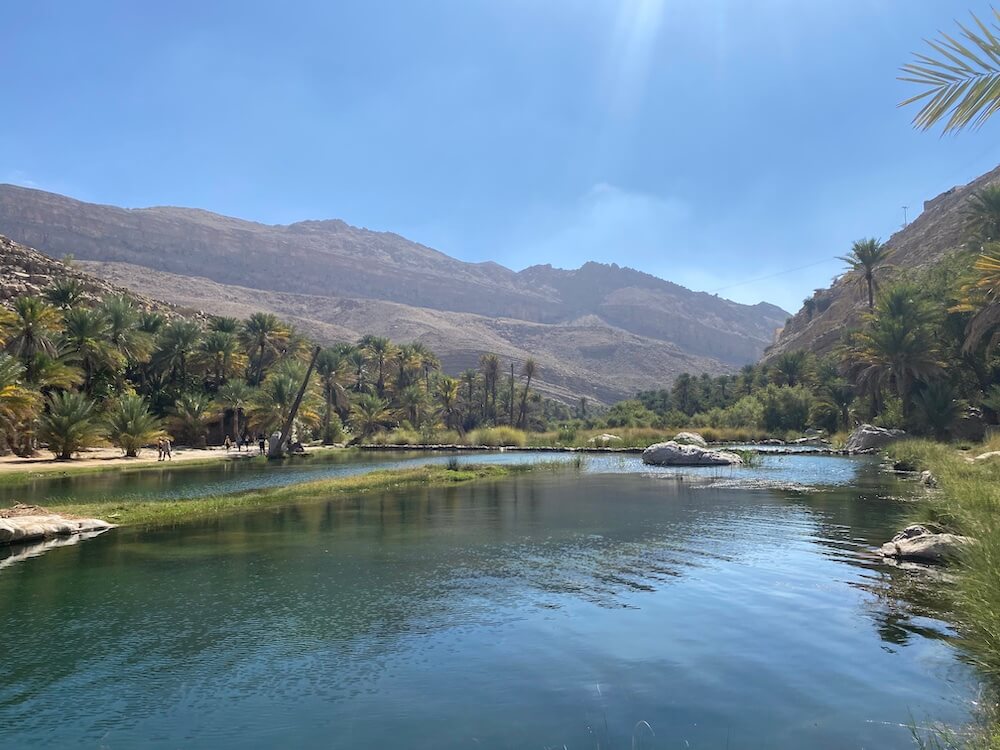
At Wadi Bani Khaled, you can swim in natural pools, relax and have lunch at the water’s edge, stroll around the oasis, hike through narrow canyons and even explore hidden caves. The refreshingly cool water makes it a popular spot to escape the heat but it wasn’t crowded when we went.
This hidden wadi is an excellent choice if you’re looking for an outdoor experience that offers both relaxation and a short hike.
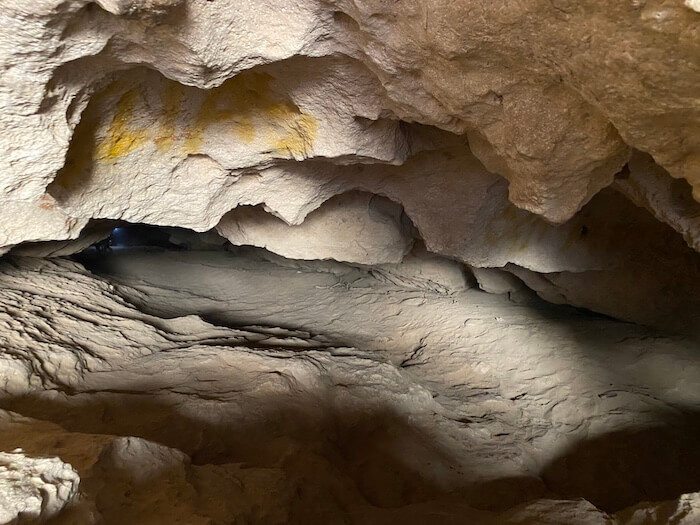
If you want to go up the wadi, you need either waterproof shoes or ones you can easily take off as you walk through water at a couple of points. You only need hiking boots if you’re going to go for a longer hike. I just wore Skechers and went as far as Wadi Bani Khalid cave.
It’s easily accessible by car on a paved road but you’ll have to park a little away from the oasis, depending on how busy it is. It took us just a few minutes to walk. You don’t need to go on the hike. You can just sit and enjoy the spectacular view of the oasis and lake at Wadi Bin Khalid.
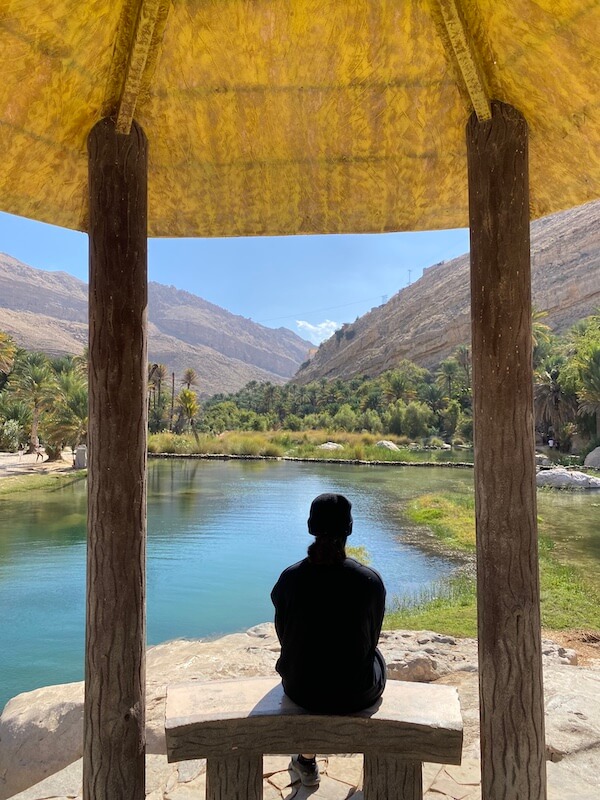
The restaurant serves meals and some snacks. There were some tour groups, though, making waiting time a bit longer. We bought tea and snacks at the little kiosk on the way out.

- The drive from Sur to Wadi Bani Khalid took us around an hour and a half.
- The drive from Muscat to Wadi Bani Khalid takes around 2 hours and 45 minutes.
- How to get to Wadi Bani Khalid from Muscat? – Take Route 1 out of Muscat, then merge onto Route 15, look out for the exit onto Route 23 towards Ibra, and continue on that route until Romail, where you’ll see the exit to Wadi Bani Khalid signposted. From there, it’s about half an hour to the oasis.
- Can you swim in the lake at Oasis Wadi Bani Khalid? Yes, you can, and also in pools in the wadi.
Where to stay near Wadi Bani Khalid?
Al Joud Green Hostel (not a hostel!) has a private pool, plunge pool, hot tub and a great location. It also allows pets and has excellent reviews with a rating of 9.6 Exceptional.
Book this fantastic two-bedroom chalet with private pool and mountain view
Route back through Nizwa, Al Hamra, Misfat Abriyeen and Jebel Shams
From Wadi Bani Khalid, we continued to Al Hamra near Nizwa and stayed in a restored old house in the old part of town. This experience is wonderfully unique, especially wandering through the alleys and nearby farms.
We visited the scenic oasis and the old town of Misfat Abriyeen the following day. Next, we ascended Jebel Shams for an overnight stay in a stone house and an unmissable hike along the canyon side the following day.
I have included more details of this and other areas to visit nearby in my updated post Best Things to do in Nizwa and around Nizwa. If you haven’t explored this area yet, I highly recommend it.
You can find some recommendations of hotels on the Nizwa post but we stayed at Al Hamra Old House and The Mountain Rest House at Jebel Shams..
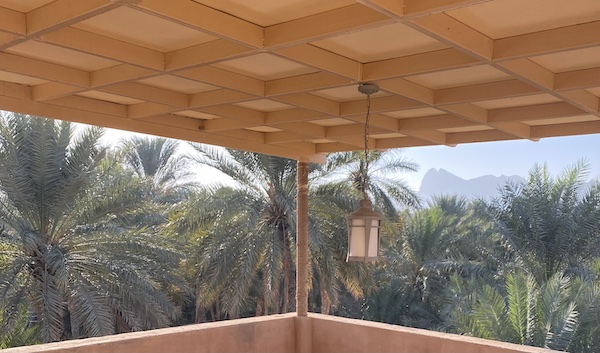
Other options along the Oman coast
Sohar
We didn’t stop off in Sohar this time on our road trip to Oman North-east Coast, however, if you want to break your journey there, the best places to visit in Sohar Oman include the 13th-century fort, the souq, corniche and Sultan Al Qaboos Grand Mosque. There are lots of cafes and Omani restaurants along the corniche.
Sohar Fort has a long history, with modifications made by the Portuguese during their occupation and eventually being restored in the late 20th century. It has a small museum that gives an insight into the region’s eventful past. It opens weekdays (Sun-Thurs) from 9am to 1pm.
The coastal Sohar to Muscat Road takes around 2 hours and 10 minutes and the Batina Highway takes about 10 minutes longer.
Where to stay in Sohar?
- Beach front apartment (9.2) – See more or book now
- Radisson Blu Sohar beachfront hotel with pool, choice of restaurants (8.0)- Book now
Wadi Al Arbeieen
We didn’t stop here but I have it on my radar for the next trip! There is a small resort, which has great reviews, and you can go hiking and swimming in pools there. It’s just under two hours drive from Muscat to Wadi Al Arbeieen and an hour and a half from Wadi Al Arbeieen to Sur.
Where to stay in Wadi Al Arbeieen?
Wadi Al Arbeieen Resort – beautiful setting in the wadi and great hospitality (9.0) You really should book this!
Important things to know about driving in Oman
If you’re heading on a road trip to Oman from another GCC country, you need to have insurance. If your current insurance covers you, you just need to bring a copy of your orange card (no longer orange!) A digital copy is fine. If you don’t have insurance, you can buy it at the border.
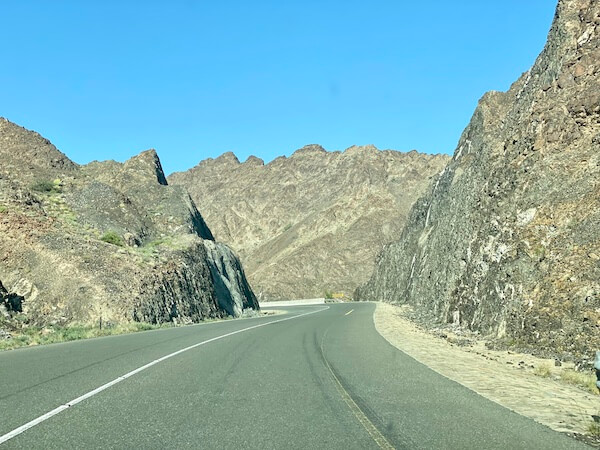
If you’re arriving from outside the Gulf, you don’t need an International Driving Permit unless your licence is neither in English nor Arabic.
In Oman, you drive on the right like other Gulf countries. Seat belts are mandatory and there is zero tolerance for drinking and driving. If your car is dusty from being off-road, be sure to wash it as a dirty car can get you a fine in Oman. According to the authorities, there is no buffer zone when it comes to speed so it’s best to stick to the limits.
Oh, and watch out for goats once you leave the city. They’re everywhere. In fact, I always say, if you went to Oman and didn’t see a goat in a random place, you’ve not been to Oman!
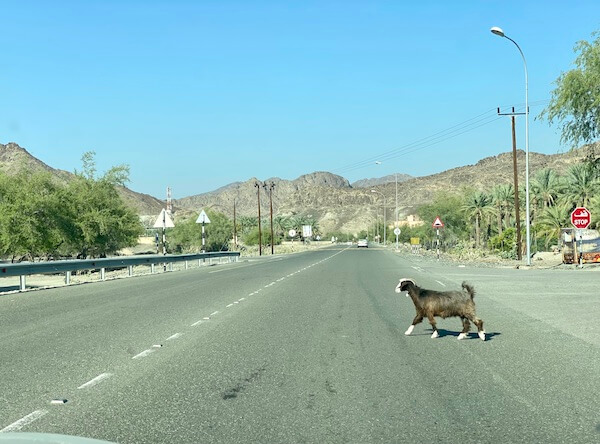
A final word on our road trip to Oman north-east coast
As you can see, we had an amazing trip to the Oman north-east coast and we can’t wait to explore more. In the meantime, we have beautiful memories of wadis, pools, beaches, turtles, souqs and lovely Omani people.
What I love most about travelling to Oman, especially when coming from another Gulf country is the slow pace, the simpler, yet beautiful, surroundings and interaction with the locals. If you haven’t been to Oman yet, what are you waiting for? Bookmark this post and start planning!
If you like this post, you may also like Best Things to do in Nizwa and around Nizwa and Musandam (northern enclave.)
🛏️ Find places to stay in Muscat and northeastern Oman ⬇️
Follow on Instagram or Facebook
Read about our trips to Oman
Visit my website on the United Arab Emirates

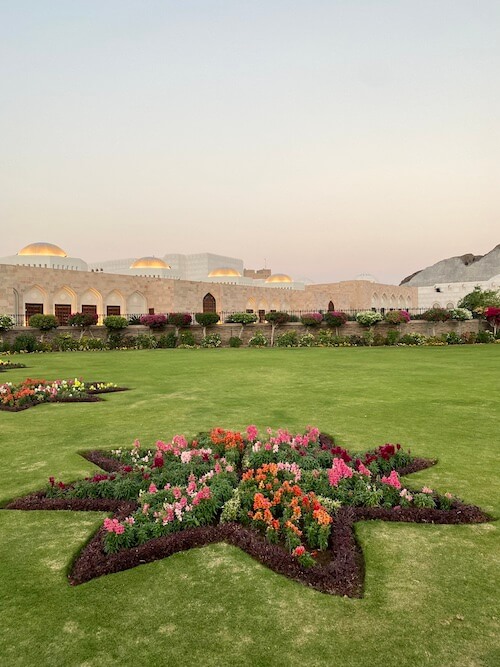
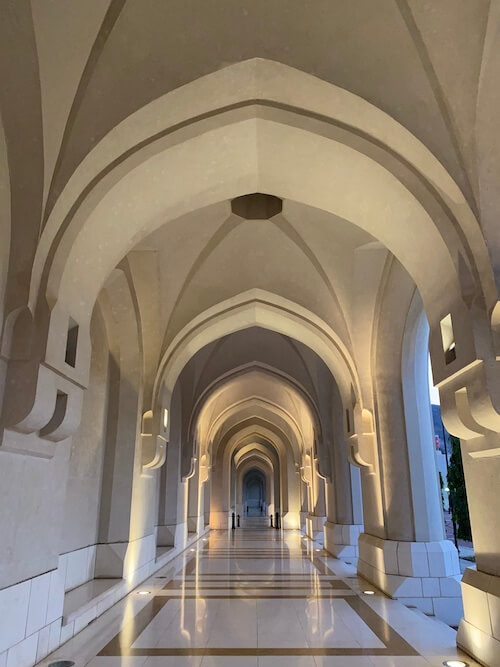
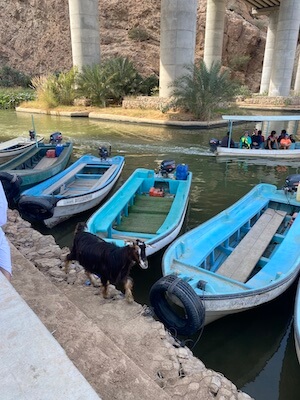
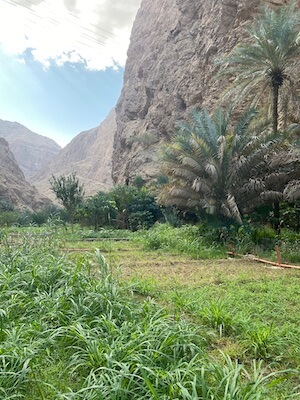
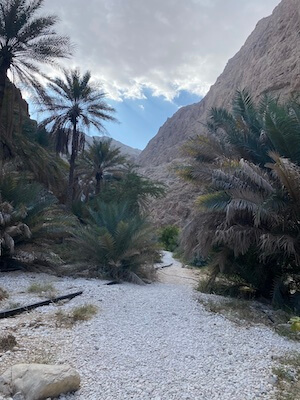
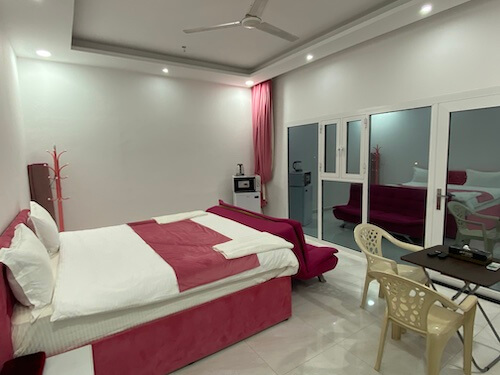
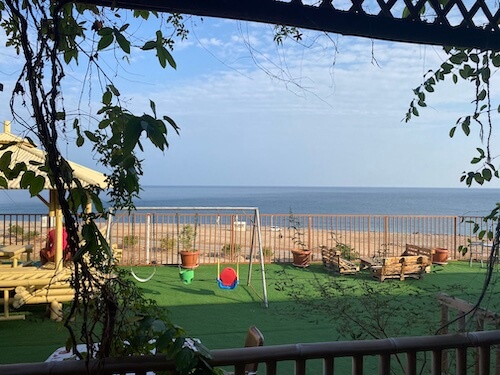
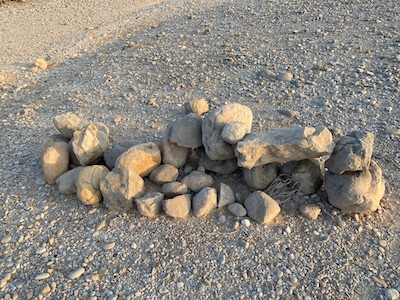
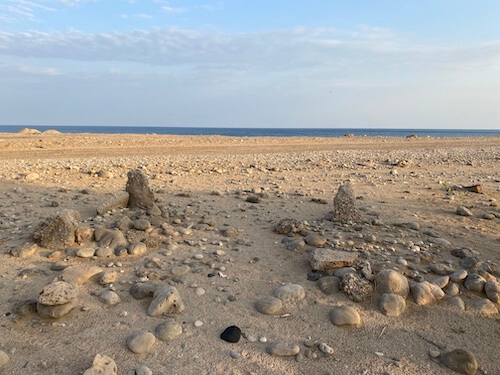
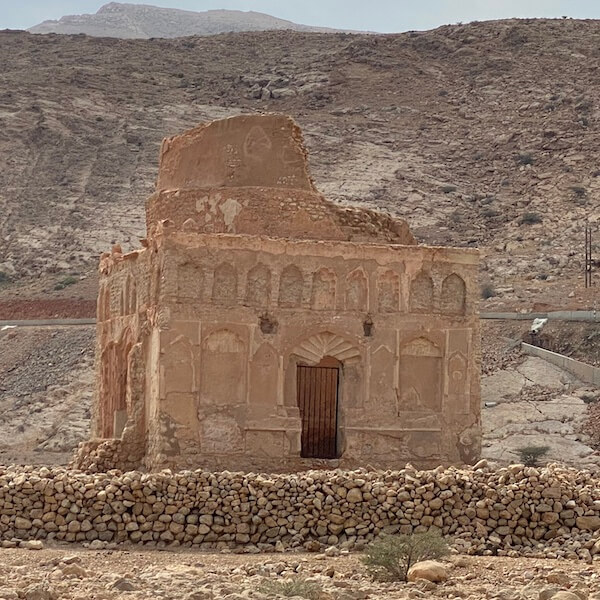
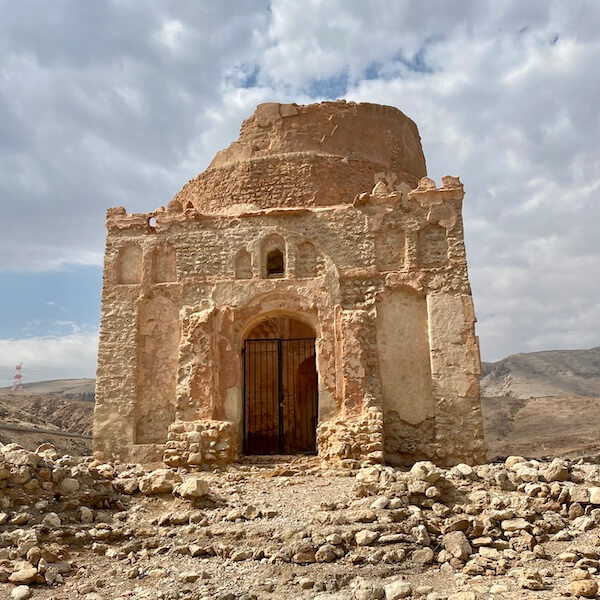
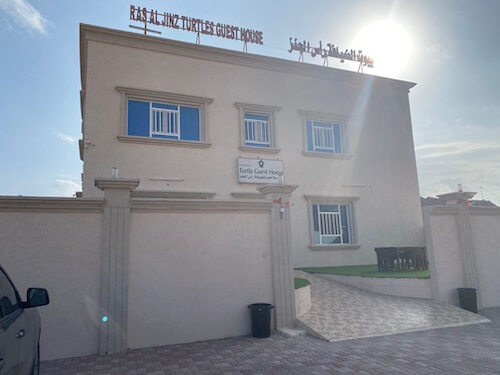
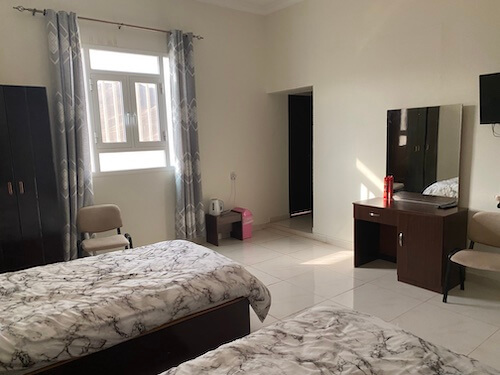
I loved Oman. Especially the wadis. Thanks for the memories!
Nice work
Thank you!